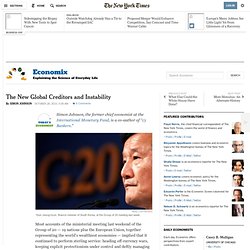

Foreign central banks' US debt holdings fall - Fed. 5.18.11 Companies Fill Up on Debt Before Fed Ends Easy Credit. J.P. Morgan Clears the Air on Derivatives - Deal Journal. By Katy Burne of Dow Jones Newswires Financial derivatives, including bets on wobbly mortgage-related securities, were blamed for nearly blowing up the economy three years ago.

Last year’s Dodd-Frank financial overhaul law was supposed to blaze sunshine onto the $583 trillion global market for over-the-counter derivatives, or those transactions carried out in private rather than on open exchanges. Bloomberg News Chris Dodd J.P. On the other side of the trades were a large unnamed U.S. bank; BlueCrest Capital Management; BlueMountain Capital Management; Diamond Notch Asset Management LLC; DCI LLC; and Pine River Capital Management LP.
Each traded different credit-default swaps electronically through a platform run by MarketAxess Holdings, which until now was better known for bond trading. J.P. “From our perspective, today was about giving our clients the confidence that we have the infrastructure to do this across a number of client types, trade types, and clearing choices. J.P. Here comes $4 gasoline - Street Sweep: Fortune's Wall Street Blog. U.S. oil prices look reassuringly calm till you look below the surface.

At first blush, a replay of the 2008 gas price spike seems far fetched. The biggest driver of U.S. gasoline prices is the cost of crude oil, and near-month oil futures on the New York Mercantile Exchange have sat out the scorching commodities rally. They lately fetched $85, some 40% below the crisis peak. Food for unsettling thoughts But that's where the good news ends for motorists -- and for a U.S. economy that is sputtering even with gas at $3.15 a gallon. Purchasing power parity. GDP per capita by countries in 2013, calculated using PPP exchange rates[1] Theories that invoke purchasing power parity assume that in some circumstances (for example, as a long-run tendency) it would cost exactly the same number of, say, US dollars to buy euros and then to use the proceeds to buy a market basket of goods as it would cost to use those dollars directly in purchasing the market basket of goods.

Big Mac Index. A McDonald's Big Mac.

How many burgers you get for US$50? (Jan 2012) The Big Mac Index is published by The Economist as an informal way of measuring the purchasing power parity (PPP) between two currencies and provides a test of the extent to which market exchange rates result in goods costing the same in different countries. It "seeks to make exchange-rate theory a bit more digestible".[1] Overview[edit] The Big Mac index was created by Ng Yat-chiu[2] and introduced in The Economist in September 1986 by Pam Woodall[3] as a semi-humorous illustration of PPP and has been published by that paper annually since then.
UBS Wealth Management Research has expanded the idea of the Big Mac index to include the amount of time that an average worker in a given country must work to earn enough to buy a Big Mac. For example, using figures in July 2008:[6] LSTA Home Page. Justice Department Seeks Tougher Derivatives Rules. Andrew Harrer/Bloomberg News.

The Inevitable Growth of Derivatives Exchanges. The World Of Derivatives Has Changed Derivatives exchanges for the trading, clearing and settlement of options and futures is nothing new; they’ve pretty much been a fact for over 30 years.

And volume growth at these exchanges is exploding, regardless of the venue - ICE, ISE, NYMEX, CME, etc. They are all flourishing amidst rising market volatility and rising transaction volumes in general. That said, exchanges continue to miss an enormous part of the derivatives trading and hedging activity that happens in the over-the-counter (OTC) market.
Back when I was a derivatives structurer and marketer, the OTC market was THE place for derivatives transactions, particularly in the fixed income, foreign exchange, credit and commodities markets. Why OTC Markets are Still Enormous Even in light of the clear benefits of exchanges - transparency, standardized documentation, centralized credit, clearing and settlement functions - the OTC markets have continued to thrive. Exchanges Are Designed To Help. Derivative-Disclosure Rules May Lift Transaction Costs. Forex. The New Global Creditors and Instability. Simon Johnson, the former chief economist at the International Monetary Fund, is a co-author of “13 Bankers.”

Nicky Loh/ReutersYoon Jeung-hyun, finance minister of South Korea, at the Group of 20 meeting last week. Most accounts of the ministerial meeting last weekend of the Group of 20 — 19 nations plus the European Union, together representing the world’s wealthiest economies — implied that it continued to perform sterling service: heading off currency wars, keeping explicit protectionism under control and deftly managing the process of reforming governance at the International Monetary Fund. Post-financial crisis, middle-income countries continue to rise in economic importance, and the recent shift in global leadership from the Group of 7 (the United States, Canada, Britain, Italy, France, Germany and Japan) to the G-20 is commonly supposed to accommodate the growing claims of “emerging markets” on the world stage.